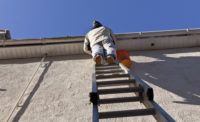Falls remain a leading cause of unintentional injury mortality nationwide, and 43% of fatal falls in the last decade have involved a ladder.
Among workers, approximately 20% of fall injuries involve ladders. Among construction workers, an estimated 81% of fall injuries treated in U.S. emergency departments (EDs) involve a ladder.
To fully characterize fatal and nonfatal injuries associated with ladder falls among workers in the United States, NIOSH analyzed data across multiple surveillance systems: 1) the Census of Fatal Occupational Injuries (CFOI), 2) the Survey of Occupational Injuries and Illnesses (SOII), and 3) the National Electronic Injury Surveillance System–occupational supplement (NEISS-Work).
In 2011, work-related ladder fall injuries (LFIs) resulted in 113 fatalities (0.09 per 100,000 full-time equivalent [FTE] workers), an estimated 15,460 nonfatal injuries reported by employers that involved more than one days away from work (DAFW), and an estimated 34,000 nonfatal injuries treated in EDs.
Rates for nonfatal, work-related, ED-treated LFIs were higher (2.6 per 10,000 FTE) than those for such injuries reported by employers (1.2 per 10,000 FTE). LFIs represent a substantial public health burden of preventable injuries for workers.
Men and Hispanics had higher rates of fatal and nonfatal LFIs compared with women and non-Hispanic whites and persons of other races/ethnicities. LFI rates increased with age, except for injuries treated in EDs. Fatality rates were substantially higher for self-employed workers (0.30 per 100,000 FTE workers) than salary/wage workers (0.06 per 100,000 FTE workers).
Establishments with the fewest employees had the highest fatality rates. The construction industry had the highest LFI rates compared with all other industries. Across all industries, the highest fatal and nonfatal LFI rates were in the following two occupation groups: construction and extraction (e.g., mining) occupations, followed by installation, maintenance, and repair occupations.
Head injuries were implicated in about half of fatal injuries (49%), whereas most nonfatal injuries involved the upper and lower extremities for employer-reported and ED-treated nonfatal injuries.
Severity of nonfatal LFIs was assessed using median DAFW (for employer-reported injuries) and disposition after ED treatment. Those with the highest median DAFW included men (21 days), workers aged 45–54 years (25 days), Hispanics (38 days), and construction and extraction workers (42 days).
Workers with lower extremity (22 days) and multiple body part (28 days) injuries had higher median DAFW compared with other injuries. The hospital admission rate for ED-treated LFIs was 14%, almost three times the estimated overall hospital admission rate of 5% in the NEISS-Work survey for 2011, suggesting that LFIs were more severe compared with all other ED-treated injuries.
Fall height was documented for 82 of 113 fatalities and an estimated 11,400 of 34,000 nonfatal ED-treated LFIs. For nonfatal LFIs, nearly 90% were from height less than 16 feet and fall heights of 6–10 feet were most common, accounting for 50% of ED-treated LFIs. For fatal LFIs, fall heights of 6–10 feet were most common but accounted for only 28% of all fatalities.
To prevent ladder falls, employers should consider the following steps:
1) plan the work to reduce or eliminate the need for using ladders by applying safety-in-design and constructability principles to finish as much of the work as possible on the ground;
2) provide alternative, safer equipment for extended work at elevation, such as aerial lifts, supported scaffolds, or mast climbing work platforms;
3) provide properly selected and thoroughly inspected ladders, that are well-matched to employee weight, task, and location;
4) when applicable, provide proper accessories to supplement safe ladder use; and
5) provide adequate ladder safety information and training for employees. Familiarity and compliance with the provisions of safety regulations, such as recognizing ladder types and conditions, and using ladder positioning and other safe ladder practices, are crucial to reducing injuries from ladder falls.
Acknowledgments
Miriam Birdwell, Bureau of Labor Statistics. Suzanne Marsh, Audrey Reichard, Susan Derk, Srinivas Konda, Scott Hendricks, National Institute for Occupational Safety and Health, CDC.
Source: NIOSH www.cdc.gov/mmwr/









